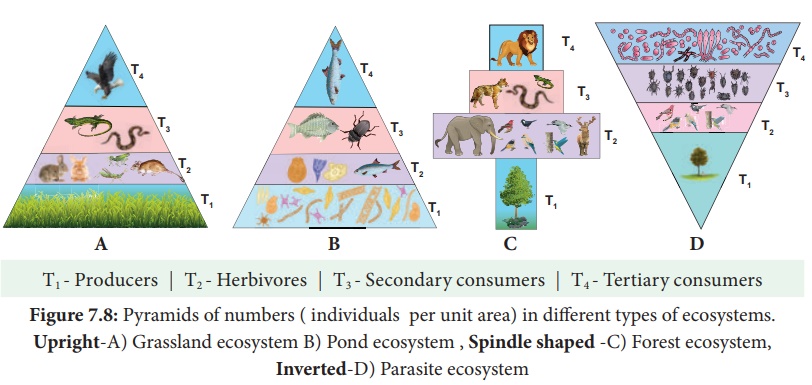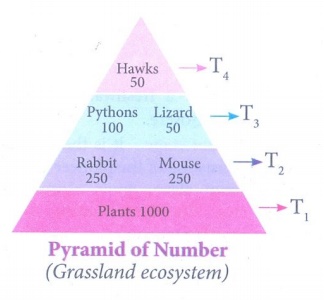Ecosystem | Botany - Answer the following questions | 12th Botany : Chapter 7 : Ecosystem
Chapter: 12th Botany : Chapter 7 : Ecosystem
Answer the following questions
Botany : Ecosystem
Answer the following questions
15. Productivity of profundal zone will be low. Why?
Answer: (i) The deeper region of a pond below the limnetic zone is
called profundal zone with no effective light penetration and predominance of
heterotrophs. Hence producers are not found here.
(ii) The primary productivity through photosynthesis of
littoral and limnetic zone of the pond is more due to greater penetration of
light than the profundal zone.
16. Discuss the gross primary productivity is more efficient than net primary productivity.
Answer: Gross Primary Productivity (GPP)
The total amount of
food energy or organic matter or biomass produced in an ecosystem by autotrophs
through the process of photosynthesis is called gross primary productivity.
Net Primary Productivity (NPP)
The proportion of
energy which remains after respiration loss in the plant is called net primary productivity. It is also
called as apparent photosynthesis. Thus the difference between GPP and
respiration is known as NPP.
NPP = GPP -
Respiration
Thus GPP is more
efficient than NPP.
17. Pyramid of energy is always upright. Give reasons
Answer: A graphical representation of energy flow at each
successive trophic level in an ecosystem is called pyramids of energy. The bottom of the pyramid of energy is occupied
by the producers. There is a gradual decrease in energy transfer at successive
tropic levels from producers to the upper levels. Therefore, the pyramid of
energy is always upright.
18. What will happen if all producers are removed from ecosystem?
Answer: If all producers are removed, then there will be no
primary productivity and there will be no biomass available for consumption by
higher trophic levels or heterotrophs. Thus the food chain / food web will
collapse leading to destruction of organisms and will affect functioning of
ecosystem.
19. Construct the food chain with the following data. Hawk, plants, frog, snake, grasshopper.
Answer:

Plants Producers → Grasshopper Primary
consumers → Frog Secondary consumers → Snakes Tertiary consumers → Hawks Top carnivores
20. Name of the food chain which is generally present in all type of ecosystem. Explain and write their significance.
Answer: The movement of energy from producers upto top carnivores
is known as food chain, i.e., in any food
chain, energy flows from producers to primary consumers, then from primary
consumers to secondary consumers, and finally secondary consumers to tertiary
consumers. Hence, it shows linear network links. Generally, there are two types
of food chain, (1) Grazing food chain and (2) Detritus food chain.
Grazing food chain is present in all ecosystem. Main source of energy for the grazing food chain is the Sun. It begins with the first link, producers (plants). The second link in the food chain is primary consumers (mouse) which get their food from producers. The third link in the food chain is secondary consumers (snake) which get their food from primary consumers. Fourth link in the food chain is tertiary consumers (eagle) which get their food from secondary consumers.
Grass Producers --→ Mouse Primary consumers --→ Snake Secondary consumers ---→ Eagle Tertiary consumers
21. Shape of pyramid in a particular ecosystem is always different in shape. Explain with example.
Answer: Graphic representation of the trophic structure and
function at successive trophic levels of an ecosystem is called ecological pyramids. The concept of
ecological pyramids was introduced by Charles
Elton (1927). Thus they are also called as Eltonian pyramids.


There are three types:
(1) pyramid of number (2) pyramid of biomass (3) pyramid of energy.
Pyramid of number (Example)
A graphical
representation of the number of organisms present at each successive trophic
level in an ecosystem is called pyramids
of number. There are three different shapes of pyramids upright, spindle
and inverted.
There is a gradual
decrease in the number of organisms in each trophic level from producers to
primary consumers and then to secondary consumers, and finally to tertiary
consumers. Therefore, pyramids of number in grassland and pond ecosystem
are always upright.
In a forest ecosystem the pyramid of number
is somewhat different in shape, it is because the base (T1) of the
pyramid occupies large sized trees (Producer) which are lesser in number.
Herbivores (T2) (Fruit eating birds, elephant, deer) occupying
second trophic level, are more in number than the producers. In final trophic
level (T4), tertiary consumers (lion) are lesser in number than the
secondary consumer (T3) (fox and snake). Therefore, the pyramid of
number in forest ecosystem looks spindle
shaped,
The pyramid of number
in a parasite ecosystem is always inverted, because it starts with a
single tree. Therefore there is gradual increase in the number of organisms in
successive tropic levels from producer to tertiary consumers.
22. Generally human activities are against to the ecosystem, where as you a student how will you help to protect ecosystem?
Answer: If we change our everyday life style, we can help to
protect the planet and its ecosystem. Therefore, we have to practice the
following in our day to day life:
(i) Buy and use only ecofriendly products and recycle them.
(ii) Grow more trees
(iii) Choose sustained farm products (vegetables, fruits,
greens, etc.)
(iv) Reduce the use of natural resources.
(v) Recycle the waste and reduce the amount of waste you
produce.
(vi) Reduce consumption of water and electricity.
(vii) Reduce or eliminate the use of house-hold chemicals and
pesticides.
(viii) Maintain your cars and vehicles properly. (In order to
reduce carbon emission)
(ix) Create awareness and educate about ecosystem protection
among your friends and family members and ask them to find out solution to
minimise this problem.
Go green
(i) It refers to the changing of one’s lifestyle for the safety
and benefits of the environments (Reduce, Reuse, Recycle)
(ii) Way to go green and save green
(a) Close the tap when not in use.
(b) Switch off the electrical gadgets when not in use.
(c) Never use plastics and replace them with biodegradable
products
(d) Always use ecofriendly technology and products.
23. Generally in summer the forest are affected by natural fire. Over a period of time it recovers itself by the process of successions . Find out the types of succession and explain.
Answer: Secondary succession:
(i) The development of a plant community in an area where an
already developed community has been destroyed by some natural disturbance. Ex. Fire is known as secondary
successions.
(ii) Generally, this succession takes less time than the time
taken for primary successions. Ex:
The forest destroyed by fire and excessive lumbering may be re-occupied by
herbs over period of times.
24. Draw a pyramid from following details and explain in brief.
Quantities of organisms are given-Hawks-50,
plants-1000.rabbit and mouse-250 +250, pythons and lizard- 100 + 50 respectively.
Answer:

Pyramid of Number
(Grassland ecosystem)
This is a pyramid of
number and is based on grassland ecosystem.
(i) The number of producers is maximum. (1000)
(ii) This is followed by primary consumers. (500)
(iii) This is followed by secondary consumers. (150)
(iv) The tertiary consumers are lesser than secondary
consumers. (50)
Therefore there is a gradual decrease in the number of organisms in each trophic level from producers to tertiary consumers. Therefore the pyramid of number in grassland ecosystem is upright.
25. Various stages of succession are given bellow. From that rearrange them accordingly. Find out the type of succession and explain in detail.
Reed-swamp stage, phytoplankton stage, shrub stage, submerged plant stage, forest stage, submerged free floating stage, marsh medow stage.
Answer: This is hydrosere plant succession
This type of
succession starts in regions where water is plenty.
(i) Phytoplankton stage
(ii) Submerged plant stage
(iii) Submerged free floating stage
(iv) Reed-Swamp stage
(v) Marsh meadow stage
(vi) Shrub stage
(vii) Forest stage
The succession in a
freshwater ecosystem is referred to as hydrosere.
1. Phytoplankton stage - It is the first stage of succession consisting
of the pioneer community like blue green algae, green algae, diatoms, bacteria,
etc., The colonization of these organisms enrich the amount of organic matter
and nutrients of pond due to their life activities and death.
2. Submerged plant stage - As the result of death and decomposition of
planktons, silt brought from land by rain water, lead to a loose mud formation
at the bottom of the pond. Hence, the rooted submerged hydrophytes begin to
appear on the new substratum. Example: Chara, Utricularia. The death and decay of these plants will build up the
substratum of pond to become shallow and replaces another group of plants which
are of floating type.
3. Submerged free floating stage - During this stage,
the depth of the pond will become almost 2-5 feet. Hence, the rooted
hydrophytic plants colonise the pond. Example:
Rooted floating plants like Nelumbo,
Nymphaea and Trapa. Some free
floating species like Azolla, Lemna, Wolffia and Pistia are
also present in this stage. By death and decomposition of these plants, further
the pond becomes more shallow and floating plant species is gradually replaced
by another species.
4. Reed-swamp stage - It is also called an amphibious stage. During this
stage, rooted floating plants are replaced by plants which can live
successfully in aquatic as well as aerial environment. Example: Typha, Phragmites.
At the end of this stage, water level is very much reduced, making it
unsuitable for the continuous growth of amphibious plants.
5. Marsh meadow stage - When the pond becomes swallowed due to
decreasing water level, species of Cyperaceae and Poaceae such as Carex, Juncus, etc., colonise the area.
They form a mat-like vegetation with the help of their much branched root
system. This leads to an absorption and loss of large quantity of water. At the
end of this stage, the soil becomes dry and the marshy vegetation disappears
gradually and leads to shrub stage.
6. Shrub stage - As the disappearance of marshy vegetation continues, soil
becomes dry. Hence, these areas are now invaded by terrestrial plants like
shrubs (Salix and Cornus) and trees (Populus and Alnus). These plants absorb
large quantity of water and make the habitat dry. Further, the accumulation of
humus with a rich flora of microorganisms produce minerals in the soil,
ultimately favouring the arrival of new tree species in the area.
7. Forest stage - It is the climax community of hydrosere. A variety of
trees invade the area and develop any one of the diverse type of vegetation. Example: Temperate mixed forest (Ulmus, Acer and Quercus),
Tropical rain forest (Artocarpus and Cinnamomum) and Tropical deciduous
forest (Bamboo and Tectona).
In the 7 stages of hydrosere succession, stage 1 is occupied by pioneer community, while the stage 7 is occupied by the climax community. The stages 2 to 6 are occupied by seral communities.
Related Topics